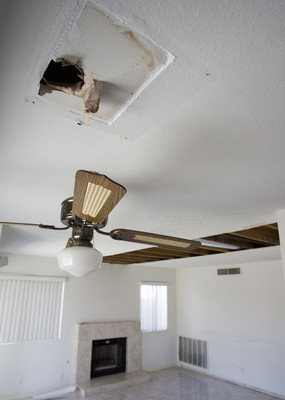Home Sour Home




The orange “no trespassing” sticker is faded, the seal it once formed over the doorway broken for at least six months. Joseph Kraemer twists the lockbox key and issues a warning to be prepared.
“I’m told that the previous owner left the water running,” the Century 21 real estate broker explains.
The tour begins at a wooden stairwell stripped of carpeting.
“I have no idea what that is,” Kraemer says of the mysterious black patches.
The more of the house he shows, the less the water damage appears accidental. Nearly every door and low cabinet displays a foot-size hole, and the master bathroom mirror suggests that not everyone is superstitious about seven years’ bad luck.
As many as 25 percent of Las Vegas’ bank-foreclosed homes suffer intentional damage, according to an informal R-J survey of valley appraisers and real estate agents. According to Thomas Blanchard, owner/broker of First Realty Group, this damage — most of which is inflicted in the four to 12 months between the notice of default and the constable’s knock at the door — typically requires $3,000 to $10,000 to repair. However, it can approach or exceed 10 percent of a home’s total value.
“Some of the time, the house’s worth is a detriment to the land value,” says Blanchard. “It’s amazing what some people will do to their houses.”
The percentage of foreclosures with damage is actually on the decline, the interview subjects agree.
“In the late ’90s, 60 percent were damaged,” Blanchard says. “It’s a lot less now due to the fact that a lot more new homes are being foreclosed on. Some have never even been lived in.”
At the same time, the number of damaged houses is rising because of the sheer explosion of foreclosures. (In September alone, 5,504 were reported in Nevada, the nation’s highest rate for the ninth month running, according to a monthly study by RealtyTrac, an online foreclosure marketplace.)
Most observers see retributory vandalism as a laceration on the already festering boil that is Las Vegas’ foreclosure problem. In addition to diminishing adjacent land values, vacant houses in disarray attract both vermin and criminals.
“I can’t count how many times someone’s broken into one of these homes to steal the copper pipes,” Blanchard says.
With a wincing smile, the middle-age man launches a photo CD-ROM at his desk computer and scrolls through broken windows, yanked-off sink tops and other scenes reminiscent of what The Who once did to hotel rooms. It’s part of Blanchard’s job to snap these photos and advise banks whether to restore their newly acquired properties or sell them as-is.
“I thought this was blood at first,” Blanchard says, stopping at a photo of red spatters on a stucco ceiling. (It’s Kool-Aid.)
Inferring motivation for intentional damage is not an exact science. Neglect, mental and/or drug impairment, and financial desperation — appliances are almost always missing — are difficult to rule out. However, some situations seem to point only to vengeance.
“When you think about the mind-set of people when they came to town in ’04, we were the get-rich-quick city,” says Loreen Stuhr, owner of appraisersoflasvegas.com. “You move to town, invest in a property and make a hundred thousand on your house.
“But it didn’t work out that way,” she says. “And the frustration of losing everything can be overwhelming — especially for the ones who relocated here.”
Blanchard arrives at the photo he has been searching for. The kitchen countertops and cabinet doors in this foreclosed home have been smashed to bits. On the wall to the left of the sink is an illustration in felt marker.
It depicts an act of sodomy.
“Who would do that?” Blanchard asks.
Indeed, Stuhr thinks that ticked-off tenants are inflicting an equivalent — if not greater — amount of damage than the former owners.
“Sometimes the homeowner doesn’t tell them, until the very last moment, that they’re about to go into foreclosure because their 3/1 ARM (adjustable rate mortgage) just came due and they can’t pay it with the rent,” she says. “Probably out of anger at not being told sooner, they’ll trash a house as they’re leaving.”
Whether it’s the tenants or former owners, the problem is clearly that the culprits feel as though there’s nothing to lose.
“From an economist’s point of view, this is what’s called a moral hazard,” says Stephen M. Miller, chairman of the economics department at the University of Nevada, Las Vegas. “The incentive of the (occupant) is not aligned with the incentive of the bank. The bank wants you to take good care of the house. But as soon as you’re in a position where you don’t have any ownership in it, you have no incentive to — other than your conscience.”
According to Blanchard, some of the 30 banks he represents attempt to offer incentives that ensure a home will be left undamaged.
“As long as it’s broom-clean and (the former owners) let us take photos of the property while they’re living in it,” he says, “they get about $500 if it’s essentially the same when they move out.”
Similarly, Blanchard notes, tenants typically receive $500 to $3,000 in relocation fees from the bank — depending on their rent costs — if they leave in peace.
In addition, the IRS occasionally pursues former homeowners for a gift tax on the portion of their loans forgiven by the bank, which should make the former homeowners want to help boost the sale price.
Logic has a tendency not to prevail, however, when emotions run high.
“People are upset,” Kraemer says. “They’re losing their house. A lot of times, they don’t think it’s their fault.”
Banks can shift from carrot to stick — going after the vandals in court. However, none of the interview subjects has ever heard of one doing that. (Representatives for Washington Mutual, Countrywide, HSBC and Bank of America — four of Las Vegas’ largest companies that deal in mortgages — refused to comment for this article.)
Similarly, disgraced former homeowners are not likely to go through the trouble of attempting to ding the credit reports of former tenants.
While the real estate world awaits an answer to this problem, Blanchard prefers to think of the 50 or so damaged properties among his 120 foreclosures as opportunities — at least for him and the potential Bob Vilas he hopes to entice.
“I prefer to sell (houses) like this,” Blanchard says, explaining that banks usually knock 10 percent to 15 percent off the price of as-is foreclosures, with repairs likely to total 5 percent to 7 percent.
“It gives the opportunity for someone to get into a property for a better value,” he says.
Plus, if you’re a collector of felt-marker wall art …
Contact reporter Corey Levitan at clevitan@reviewjournal.com or (702) 383-0456.
Housing in Las VegasMore InformationON THE WEB
Foreclosure Horror (slideshow)


















